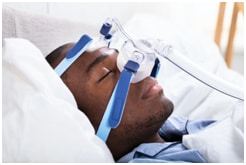Asthma
Asthma is a condition where your lungs react to things that normally shouldn’t affect you, making it difficult to breathe.
As we’ve discussed, obstructive sleep apnea (OSA) occurs when your muscles relax and the soft tissues in your mouth, throat and nose interrupt your breathing during sleep.
OSA
You might not see the relationship immediately, but asthma and obstructive sleep apnea are closely linked to each other. People with asthma are much more likely to have OSA and for those who do have OSA it makes their asthma worse.

You might not see the relationship immediately, but asthma and obstructive sleep apnea are closely linked to each other. People with asthma are much more likely to have OSA and for those who do have OSA it makes their asthma worse.
OSA is a serious health risk and if left untreated often leads to death. A partial airway blockage produces a sound: snoring. A completely blocked airway will not make any sound and is completely silent. Sleep apnea is a combination of both obstructions that occur during sleep. Aside from sleepiness, it can create a higher risk for high blood pressure, heart attack, stroke and insulin resistance.
If you suspect you have sleep apnea, you should seek treatment right away, especially if you have asthma. Schedule a consultation with your qualified dentist who can then refer you to a physician for an evaluation, diagnosis and treatment. The physician may direct your dentist to fabricate an oral appliance if it’s appropriate and you are a candidate.
Both sleep apnea and asthma are life threating and have inflammation in common. Let’s explore more so you can see how they are connected.
There are 2 key factors that play a role in the asthma and obstructive sleep apnea connection:
- Mouth-breathing
- Inflammation
Mouth Breathing and Asthma
Mouth breathing is a huge factor in the development of asthma and obstructive sleep apnea. The nose (not the mouth) should be used during breathing. This is what is known as nasal breathing; the nose has better air conditioning capacity.

By enlarging the nostrils a person’s nasal breathing improves drastically in the majority of people. Studies show that when people suffering from nighttime or morning asthma enlarged their nostrils during sleep they reduced their nighttime asthma. Any inexpensive nasal dilator such as Nozovent or Mute (or even Breath Right Strips) will help keep the nostrils enlarged while sleeping.
Mouth breathing leads to the drying and cooling of the lining of the lungs causing the airway ducts to constrict and the asthma to worsen.
Inflammation in Asthma and Obstructive Sleep Apnea
Inflammation is an immune response in which white blood cells produce chemicals to fight a foreign substance and occurs in both asthma and obstructive sleep apnea. Obstructive sleep apnea produces a low level of inflammation in an adult or child. Factors such as hereditary, lifestyle and your environment are capable of increasing this level of inflammation to epic proportions.
Belly fat produces inflammation that occurs before the start of obstructive sleep apnea. This same inflammation may also affect the lungs and cause asthma. Even as early as puberty, metabolic factors such as having a large waistline, high blood pressure, high levels of fat, cholesterol and sugar in the blood are driving the development of sleep apnea, just as we see in adults.
Researchers have found that inflammation in the lining of the upper airway results in it being more collapsible and makes OSA worse. Inflammation causes the inner lining of the airways to swell and produce mucus. This makes the airway more sensitive to asthmatic triggers.
Likelihood of asthma developing into obstructive sleep apnea according to the Centers for Disease Control and Prevention Report:
- Risk—having asthma was a risk factor for an asthmatic patient developing obstructive sleep apnea. Asthma patients face an almost 40% greater risk for sleep apnea than asthma-free patients. This risk depends on the degree of therapeutic control of the patient’s asthma: controlling asthma meant reducing the risk for being diagnosed with sleep apnea. The more uncontrolled the asthma is the more severe the sleep apnea is.
– Severity—people with obstructive sleep apnea and asthma also appear to have more severe asthma symptoms than people with asthma without obstructive sleep apnea.
– Duration—the longer a patient had bronchial asthma, the more likely that the patient would develop obstructive sleep apnea.
– Obesity—people with a BMI of 30 (obese) or more have a much higher risk of having asthma than those with a lower BMI. It is thought that belly fat tissue produces inflammatory substances that might affect the lungs and cause asthma.
– Gender—evidence suggests that the effects of asthma and obstructive sleep apnea may be worse in women.
Asthma and Obstructive Sleep Apnea Overlap:
– They occur together at the same time in a high number of cases
– They share risk factors including
- Rhinitis—runny nose, sneezing, and stuffiness.
- Obesity
- Acid reflux
- The worse the asthma severity the worse the obstructive sleep apnea severity and vice versa
- Inflammation exists both inside the body and the airway
- Both have an effect on the immune system
- Asthma-controlling medications (corticosteroids) can cause patients with asthma to develop obstructive sleep apnea.
- If obstructive sleep apnea is not adequately controlled it becomes harder to control the asthma because irregular lack of oxygen during sleep causes airway inflammation and prevents formation of healthy tissue.
Steps to Take Now:
- If you are not sure if you have asthma or OSA let your dentist know so you can be referred to the right physician for an evaluation.
- If you or a loved one has asthma make sure you also get checked for OSA especially children.
- Patients with both conditions should strive for the best control of asthma, which in turn can improve your OSA or decrease chances of getting OSA.
- If you have OSA continue to use your CPAP (continuous positive airway pressure).
- If you have both OSA and asthma, CPAP use has shown to improve asthma-specific quality of life especially in older patients.

What To Do if You Cannot Tolerate Wearing Your CPAP:
- Let the physician who prescribed the CPAP know and inform your dentist.
- Ask for and discuss other options to treat your sleep apnea.
- The physician will request an evaluation by your dentist to see if you are a candidate for oral appliance to treat your OSA.

